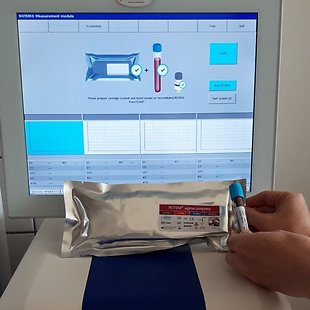Practical use of viscoelastic methods
Viscoelastic methods and ROTEM/ClotPro machines examine the coagulation status and mechanical properties of the coagulum in real time during its formation, stabilization and lysis. The examination can be performed immediately after blood collection. They are also referred to as "bedside" tests. The advantage of viscoelastic methods lies in the speed of examination and the possibility of targeted therapy - targeted choice of transfusion products according to the results, reduction of their consumption and reduction of stress for the patient’s organism. They can be used successfully in the treatment of life-threatening bleeding in severe trauma, evaluation of the haemocoagulation status before or during surgery. The interactive algorithm explains the use and interpretation of viscoelastic methods and aims to show various results of the analysis and their solutions.
Review
The applications of viscoelastic methods in perioperative care and in the management of life-threatening bleeding are nowadays necessary and important. The great advantage of these methods, in contrast to laboratory hemocoagulation tests, is the evaluation of the whole process of clot formation and its lysis in a very short time. They are done at the patient's bedside without the need of transportation to the laboratory. The validity of this approach is supported by the physiology and pathophysiology of a relatively new "cellular model of hemostasis". Thanks to a simple algorithm, rapid differential diagnosis of coagulopathy is possible, from the diagnosis of deficiency of coagulation factor or platelets, hyperfibrinolysis to the presence of the latest oral anticoagulants. The algorithm presents an everyday situation, in which thanks to the rapid diagnosis of coagulopathy, it is possible to target the necessary coagulation factors and a specific antidote. This approach prevents unnecessary and excessive administration of plasma and other coagulation factors. The unjustified administration of these may expose the patient to the risk of thrombosis or other associated complications.
Sources
Trauma induced coagulopathy. New York, NY: Springer Science+Business Media, 2016. ISBN 9783319283067. Available at: https://www.researchgate.net/publication/301484623_Rotational_thromboelastometry_ROTEMR
DURILA, Miroslav. Význam viskoelastických metod tromboelastografie/rotační tromboelastometrie (TEG/ROTEM) na jednotce intenzivní péče[online]. Praha, 2016 [cit. 2020-04-02]. Habilitation work. Charles University. Second faculty of medicine and Motol University Hospital. Available at:https://dspace.cuni.cz/handle/20.500.11956/85009
CURRY, Nicola S., Ross DAVENPORT, Sue PAVORD, et al. The use of viscoelastic haemostatic assays in the management of major bleeding. British Journal of Haematology [online]. 2018, 182(6), 789-806 [cit. 2020-04-14]. DOI: 10.1111/bjh.15524. ISSN 00071048. Available at: http://doi.wiley.com/10.1111/bjh.15524
KOZEK-LANGENECKER, Sibylle A., Aamer B. AHMED, Arash AFSHARI, et al. Management of severe perioperative bleeding. European Journal of Anaesthesiology [online]. 2017, 34(6), 332-395 [cit. 2020-04-14]. DOI: 10.1097/EJA.0000000000000630. ISSN 0265-0215. Available at: http://journals.lww.com/00003643-201706000-00003
SPAHN, Donat R., Bertil BOUILLON, Vladimir CERNY, et al. The European guideline on management of major bleeding and coagulopathy following trauma: fifth edition. Critical Care [online]. 2019, 23(1) [cit. 2020-04-27]. DOI: 10.1186/s13054-019-2347-3. ISSN 1364-8535. Available at: https://ccforum.biomedcentral.com/articles/10.1186/s13054-019-2347-3





